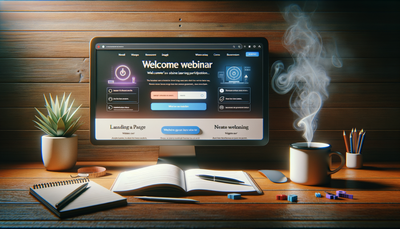Incorporating Customer Feedback into Landing Page Design
In the ever-evolving digital landscape, landing pages play a crucial role in converting visitors into customers. However, creating an effective landing page isn't a one-time task; it requires continuous improvement based on customer feedback. This article explores the importance of incorporating customer feedback into landing page design and provides practical strategies for gathering and utilizing this valuable input. We'll delve into survey techniques, user testing methodologies, and iterative design processes that can help you optimize your landing pages for better performance. By implementing these strategies, you'll be able to create landing pages that resonate with your target audience, improve user experience, and ultimately drive higher conversion rates.Table of Contents:

The Importance of Customer Feedback in Landing Page Design
Customer feedback is the lifeblood of effective landing page design. It provides invaluable insights into user preferences, pain points, and expectations, allowing you to tailor your landing pages to meet their needs. By actively seeking and incorporating customer feedback, you can:1. Identify and address usability issues
2. Improve the clarity and relevance of your messaging
3. Enhance the overall user experience
4. Increase conversion rates
5. Build trust and credibility with your audience
Remember, your landing page visitors are the ultimate judges of its effectiveness. Their feedback can reveal blind spots and opportunities for improvement that you might have overlooked. By prioritizing customer input, you can create landing pages that not only look great but also perform exceptionally well in achieving your business objectives.
Do you need a website? Want to build a website but don't know where to start? Our website builder is the perfect solution. Easy to use, and with the ability to customize to fit your business needs, you can have a professional website in no time.
Effective Survey Techniques for Gathering Customer Feedback
Surveys are a powerful tool for collecting customer feedback on your landing pages. To maximize the effectiveness of your surveys, consider the following techniques:1. Keep it short and focused: Limit your survey to 5-10 questions to increase completion rates.
2. Use a mix of question types: Combine multiple-choice, rating scales, and open-ended questions for comprehensive insights.
3. Time it right: Present the survey after the user has had sufficient time to interact with the landing page.
4. Offer incentives: Consider providing a small reward or discount for completing the survey.
5. Use exit-intent popups: Capture feedback from visitors who are about to leave the page.
When crafting your survey questions, focus on aspects such as the clarity of your messaging, the ease of navigation, the appeal of your visuals, and the overall user experience. By gathering this information, you can identify areas for improvement and prioritize changes that will have the most significant impact on your landing page performance.
Implementing User Testing for In-Depth Insights
While surveys provide valuable quantitative data, user testing offers qualitative insights that can reveal nuanced issues and opportunities. Here are some effective user testing methods for landing pages:1. Think-aloud testing: Ask participants to verbalize their thoughts as they navigate your landing page.
2. Task-based testing: Provide specific tasks for users to complete on your landing page and observe their behavior.
3. A/B testing: Create two versions of your landing page and compare their performance with real users.
4. Heat mapping: Use tools to visualize where users click and how far they scroll on your landing page.
5. Eye-tracking studies: Analyze where users focus their attention on your landing page.
When conducting user tests, aim for a diverse group of participants that represent your target audience. Pay close attention to their reactions, frustrations, and moments of delight as they interact with your landing page. These observations can provide invaluable insights for improving your design and content.
Building a website with SITE123 is easy
Analyzing and Prioritizing Customer Feedback
Once you've gathered customer feedback through surveys and user testing, it's crucial to analyze and prioritize the information effectively. Here's a step-by-step approach:1. Categorize feedback: Group similar comments and issues into categories (e.g., design, content, functionality).
2. Identify patterns: Look for recurring themes or issues mentioned by multiple users.
3. Assess impact: Evaluate the potential impact of addressing each issue on user experience and conversions.
4. Consider feasibility: Determine the effort and resources required to implement each suggested improvement.
5. Create a prioritized list: Rank the identified issues based on their impact and feasibility.
Remember to balance quantitative data from surveys with qualitative insights from user testing. This comprehensive approach will help you make informed decisions about which improvements to prioritize for your landing page redesign.
The Iterative Design Process: Continuous Improvement
Incorporating customer feedback into your landing page design should be an ongoing, iterative process. Here's a framework for continuous improvement:1. Implement changes: Start with high-priority improvements based on your analysis.
2. Test and measure: Use A/B testing to compare the performance of your updated landing page against the original version.
3. Gather new feedback: Conduct follow-up surveys and user tests to assess the impact of your changes.
4. Analyze results: Evaluate the effectiveness of your improvements and identify new areas for optimization.
5. Repeat the process: Continue this cycle of improvement, always staying responsive to customer feedback.
Remember that landing page optimization is not a one-time effort. User preferences and expectations evolve, and your landing pages should evolve with them. By embracing an iterative design process, you ensure that your landing pages remain effective and aligned with your audience's needs over time.





